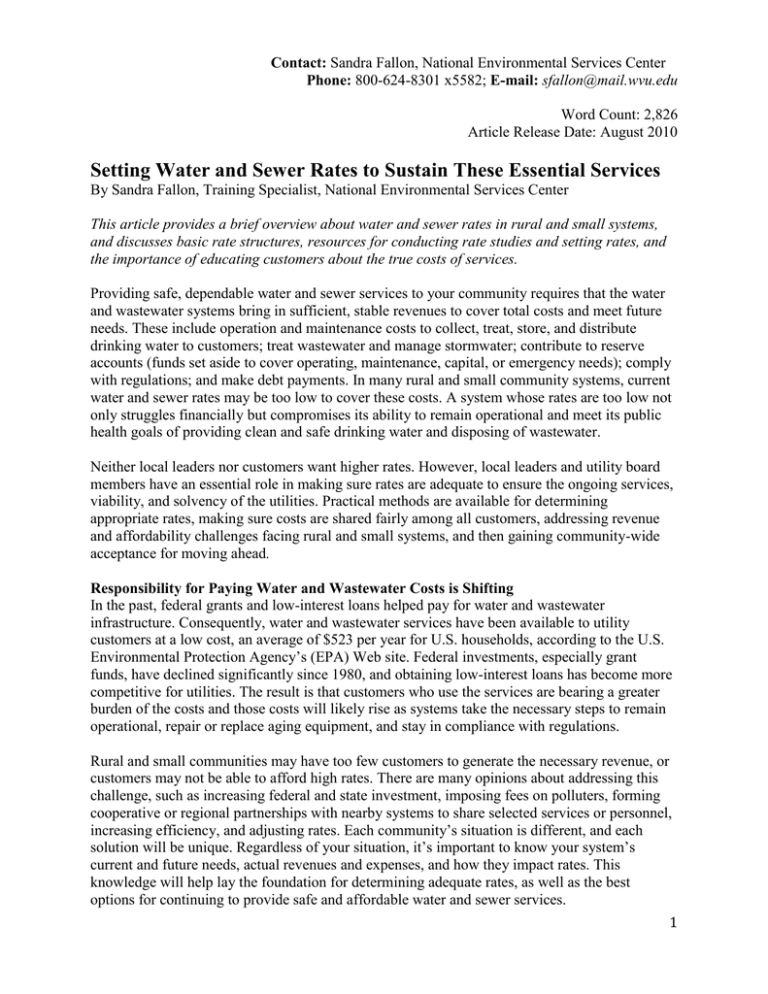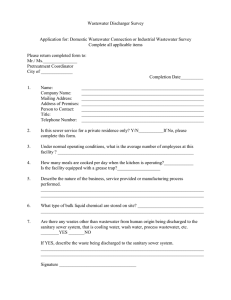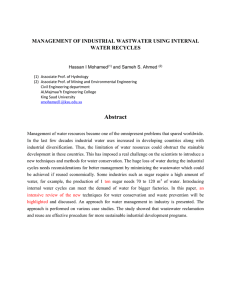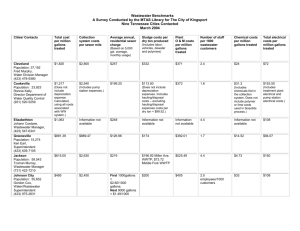Setting Water and Sewer Rates to Sustain These Essential Services
advertisement

Contact: Sandra Fallon, National Environmental Services Center Phone: 800-624-8301 x5582; E-mail: sfallon@mail.wvu.edu Word Count: 2,826 Article Release Date: August 2010 Setting Water and Sewer Rates to Sustain These Essential Services By Sandra Fallon, Training Specialist, National Environmental Services Center This article provides a brief overview about water and sewer rates in rural and small systems, and discusses basic rate structures, resources for conducting rate studies and setting rates, and the importance of educating customers about the true costs of services. Providing safe, dependable water and sewer services to your community requires that the water and wastewater systems bring in sufficient, stable revenues to cover total costs and meet future needs. These include operation and maintenance costs to collect, treat, store, and distribute drinking water to customers; treat wastewater and manage stormwater; contribute to reserve accounts (funds set aside to cover operating, maintenance, capital, or emergency needs); comply with regulations; and make debt payments. In many rural and small community systems, current water and sewer rates may be too low to cover these costs. A system whose rates are too low not only struggles financially but compromises its ability to remain operational and meet its public health goals of providing clean and safe drinking water and disposing of wastewater. Neither local leaders nor customers want higher rates. However, local leaders and utility board members have an essential role in making sure rates are adequate to ensure the ongoing services, viability, and solvency of the utilities. Practical methods are available for determining appropriate rates, making sure costs are shared fairly among all customers, addressing revenue and affordability challenges facing rural and small systems, and then gaining community-wide acceptance for moving ahead. Responsibility for Paying Water and Wastewater Costs is Shifting In the past, federal grants and low-interest loans helped pay for water and wastewater infrastructure. Consequently, water and wastewater services have been available to utility customers at a low cost, an average of $523 per year for U.S. households, according to the U.S. Environmental Protection Agency’s (EPA) Web site. Federal investments, especially grant funds, have declined significantly since 1980, and obtaining low-interest loans has become more competitive for utilities. The result is that customers who use the services are bearing a greater burden of the costs and those costs will likely rise as systems take the necessary steps to remain operational, repair or replace aging equipment, and stay in compliance with regulations. Rural and small communities may have too few customers to generate the necessary revenue, or customers may not be able to afford high rates. There are many opinions about addressing this challenge, such as increasing federal and state investment, imposing fees on polluters, forming cooperative or regional partnerships with nearby systems to share selected services or personnel, increasing efficiency, and adjusting rates. Each community’s situation is different, and each solution will be unique. Regardless of your situation, it’s important to know your system’s current and future needs, actual revenues and expenses, and how they impact rates. This knowledge will help lay the foundation for determining adequate rates, as well as the best options for continuing to provide safe and affordable water and sewer services. 1 Assess Your Situation The North Dakota Small Community Handbook on Developing and Setting Water Rates recommends asking the following questions about your current rates to help decide whether a rate adjustment is needed. A “no” answer indicates that it’s time to examine your rate structure and consider an increase. 1. Did revenue exceed system expenses each of the last three years? 2. Were you able to make scheduled payments on all long-term debt? 3. Is your system in compliance with state drinking water standards and regulations? 4. Were you able to cover the cost of emergency and preventive maintenance as needed? 5. Have you had a rate increase in the last three years? Determining the appropriate water and sewer rates takes time and effort on the part of the utility’s governing board and staff. It involves reviewing all aspects of current system operations, including your current rate structure (rate structures are explained below); true costs for all operation, maintenance, administration and management expenses, both labor and non-labor; debt retirement; and equipment, or asset, repair and replacement costs. Examining these items may require digging through bookkeeping, maintenance, and other records, and reviewing state and local laws that govern rate setting. To help determine the system’s future costs, consider developing an equipment replacement plan or asset management program to help estimate future equipment maintenance, repair, and replacement costs (see asset management resources at end of article). It’s also important to examine whether current operations are running efficiently. For example, are the appropriate management and staff in place? Can operating, maintenance, purchasing, or repair costs be lowered? Are there opportunities to team up with nearby utilities to achieve economies of scale? Do customers have water meters, and are they billed for the amount of water they use? Is the utility collecting all the money that’s owed? Is it losing treated water through leaks in the distribution system? Is water conservation encouraged? Are drinking water sources being protected from pollution? Addressing these issues can help reduce expenses and keep rates as low as possible. Conducting a Rate Study and Setting Rates After assessing your utility’s situation, conducting a rate study will help determine if current rates are adequate to cover costs, which type of rate structure is fair and equitable to all customers, and the amount of the rate increase, if needed. While it’s possible to examine your utilities and conduct a rate study in-house, some systems may benefit from securing the help of an outside expert. A qualified expert or rate analyst who is familiar with the rate study process will help ensure that you get the numbers and future projections right. Technical assistance providers, such as your state Rural Community Assistance Partnership (RCAP) affiliate or your state drinking water agency’s capacity development program, may be able to provide tools and guidance. If getting this assistance is not an option, small systems may want to assemble a committee of key utility personnel, the city auditor or billing and collection clerk, and a couple of customers to conduct the study (some states require public participation in rate setting.) Free technical assistance may be available to small, low-income communities. Another approach is to hire an expert to do the initial rate study, continue with yearly studies on your own, and bring in an expert every few years to make sure the study and the rates are on track. 2 Rate study and rate setting calculations can be lengthy and involved, but the underlying concepts are fairly clear-cut. According to the North Dakota Small Community Water System’s Handbook on Developing and Setting Water Rates, you first need to determine how much additional revenue is required to cover the full costs of operating the system. This involves preparing a budget, which is a financial plan for estimating total expenses and revenues for the upcoming year, based on your assessment of current and future costs. If your estimated expenses exceed estimated revenue, a rate increase is probably necessary. Next, consider how to spread the increase fairly among all customers. This requires knowing how many customers you have, how much water they use, and then determining if the current rate structure spreads the cost of providing water equitably among all customers, both high and low users. Ultimately, these and other calculations and projections will help determine appropriate rates to cover the full cost of doing business, now and in the future. Identifying the Right Rate Structure The rate structure determines how your system charges customers for the water they use. There are four common types: (1) Uniform Flat Rate: charging a flat rate no matter how much water is used; (2) Single Block Rate: charging a constant price per gallon regardless of how much water is used; (3) Decreasing Block Rate: charging less money as the amount of water used increases; and (4) Increasing Block Rate: charging more money as the amount of water used increases. Figure 1. provides a more detailed explanation of these rate structures. There are additional rate structure options that build upon these basics. For example, “seasonal rates” charge higher rates when there is a high demand for water, such as summer. “Lifeline rates” offer lower rates for low-income customers. Each rate structure offers benefits and disadvantages, such as encouraging or discouraging water conservation, economic development, or fair and equitable pricing. Every community has its own priorities that should be taken into account when choosing the appropriate rate structure. Traditionally, most small systems have used the single block rate structure (a constant price per gallon) or charged a flat fee for water (same price regardless of amount used). To encourage water conservation, the trend in rate structures is moving toward increasing block rates. Water conservation not only cuts down on the amount of water people use, but can help decrease a system’s costs to collect, treat, and deliver water, as well as corresponding wastewater costs. Most rate structures include a base rate, or minimum charge for having water available on demand, and a flow charge, which is a cost per 1,000 gallons, for example. The base rate typically covers the system’s fixed expenses, which are monthly costs that do not change, such as billing, payment of debt, or contributions to reserve accounts. The flow charge generally covers the variable costs, such as salaries or chemicals, which change each month as the amount of water produced changes. As a general rule, wastewater rates are based on the amount of water used, and may require seasonal adjustments. Some systems may use more than one type of rate structure. For example, high water users like industrial or commercial customers may be given special rates if the community is trying to keep or attract these entities. In these cases it’s important to consider the impact on your local water sources, and protect these water sources from pollution and overuse. Keep in mind that your state regulatory agency or public service/utility commission may need to approve rate changes. Once approved, a rate hike may be more acceptable to customers if the 3 new charges are spread incrementally over several years. Finally, funds from utility revenues and reserve accounts should not be used to pay for unrelated projects or costs. Figure 1. Types of Rate Structures Definitions User Classifications: Divide customers into groups such as residential, commercial, industrial, agricultural/seasonal. Some systems classify customers by meter size. Many systems have different rates for each classification of customers. Consumption Block: A preset quantity of water at a stated price. An example follows of a rate structure with four consumption blocks. $x for the first 2,000 gallons used $x per 1,000 from 2,000 to 6,000 gallons $x per 1,000 from 6,001 to 10,000 gallons $x per 1,000 for everything over 10,000 gallons used UNIFORM FLAT RATE SINGLE BLOCK RATE Customers pay the same amount regardless of Customers are charged a constant price per gallon regardless quantity of water used. Used in unmetered of the amount of water used. Often coupled with a minimum systems. charge for having service available. Example: Each customer charged a flat rate of $x Example: $x minimum service or base rate (optional) plus $x per month. per 1,000 gallons used. Advantages: No expense for installing, reading Advantages: Easy to administer, may encourage water meters. conservation. Cost to customer is in direct proportion to Disadvantages: All customers pay either too much amount they use. or too little for what they use. Is not based on use. Disadvantages: May discourage high water consuming Promotes high consumption. industries from locating in the service area. Not recommended. DECREASING BLOCK RATE INCREASING BLOCK RATE The price of water declines as the amount used The price of water increases as the amount used increases. increases. Each succeeding consumption block is Each succeeding consumption block is more expensive. cheaper. This structure is based on the assumption Structure based on the assumption that water rates should that costs decline as consumption goes up. promote water conservation. Example: $14 for first 2,000 gallons used; Example: $14 minimum for first 2,000 gallons used; $2.50 per 1,000 from 2,000 – 6,000 gallons; $2.00 per 1,000 from 2,000 – 6,000 gallons; $2.00 per 1,000 from 6,001 – 10,000 gallons; $2.50 per 1,000 from 6,001 – 10,000 gallons; $1.00 per 1,000 for everything over 10,000 $3.00 per 1,000 for everything over 10,000 gallons. gallons. Advantages: Promotes water conservation, especially Advantages: Attractive to large volume users. important in areas of limited water supplies or high treatment Disadvantages: Production costs may not decrease costs. Less water use means less wastewater and smaller, less with the increase in gallons of water produced. For expensive wastewater treatment facilities. Provides a a limited number of customers, low volume users reasonable amount of water at a reasonable price and charges may be subsidizing large volume users. a premium for those using more. Disadvantages: Higher costs for high usage may discourage industry from locating in service area. North Dakota Small Community Water System’s Handbook on Developing and Setting Water Rates (1999. Revised Edition). Audrey Boe Olsen. Prepared by Midwest Assistance Program under a contract with the North Dakota Department of Health. Public Education: The Most Important Factor Customers can become irate upon learning that the water and sewer rates are going up. Common complaints include “higher rates will make our water unaffordable,” “government wastes enough of our money already,” and “I won’t vote for that elected leader again.” Customers often do not understand the real issues facing water and wastewater services. Increasing their understanding and gaining their support starts with public education. Experience shows that if people understand the value and benefits of water and sewer services, they are usually willing to pay the price. 4 The EPA’s Building Support for Increasing User Fees recommends informing customers that clean water has a price, explaining what their money is purchasing, pointing out all the efficiencies you’ve put in place, and conveying the consequences of inadequate water and wastewater management. Consequences include a lack of clean water and reliable services; public health and water pollution problems; and threats to quality of life, property values, community growth, and a sustainable economy. If you’ve conducted a good rate study, you’ll have plenty of evidence to illustrate what their money is buying. Public education campaigns should start well in advance of a proposed rate increase. Effective strategies include delivering tailored messages to different audiences (local service clubs, community groups, the media, school children, the general public), using a variety of communication strategies (presentations; utility tours; local fairs and events; direct appeals through the mail; Web site, newspaper, radio, and television announcements), and delivering the messages repeatedly over time. It’s important to be well organized; use a designated, credible, and knowledgeable spokesperson; and develop a good relationship with the media and provide the information they need. If necessary, public education campaigns can be done on a shoestring budget, with a little creativity and commitment. Local Leadership is Essential to Success Many small water and wastewater systems have not raised rates in a long time and may not be adequately funded to keep up with the necessary operation, maintenance, infrastructure upgrades, and reserve accounts. Even in these difficult economic times, there are many options available to address the costs of drinking water and wastewater services. Strong local leadership and support are essential for making sure water and wastewater services are running as efficiently as possible and that there are adequate revenues to cover the full costs. Resources and References Affordability and Capability Issues of Small Water and Wastewater Systems: A Case for Regionalization of Small Systems. Deb Martin. Rural Community Assistance Partnership. http://www.rcap.org/node/88 Building Support for Increasing User Fees. July 1989. U.S. Environmental Protection Agency, Office of Water. Publication 430/09-89-006. http://nepis.epa.gov/Exe/ZyPURL.cgi?Dockey=00000KO7.txt Community Water System Survey 2000. December 2000. Volume 1: Overview. U.S. Environmental Protection Agency. EPA-815-R-02-005A. http://www.epa.gov/ogwdw000/consumer/pdf/cwss_2000_volume_i.pdf “Conservation Rates.” Spring/Summer 2010. Carl Brown. In On Tap, Vol. 10, Issue 1, pp. 28-30. http://www.nesc.wvu.edu/pdf/dw/publications/ontap/magazine/OTSPSU10_features/Conservatio n_Rates.pdf Governing the Tap: Special District Governance and the New Local Politics of Water. 2009. Megan Mullin. Massachusetts Institute of Technology Press, Cambridge, MA. How to Get Great Rates. 2009. Carl Brown. Can be ordered from http://gettinggreatrates.com 5 North Dakota Small Community Water System’s Handbook on Developing and Setting Water Rates. 1999. Revised edition. Audrey Boe Olsen, Rural Development Specialist, Midwest Assistance Program. Developed under a contract with the North Dakota Department of Health. http://www.map-inc.org/pdf/pub_water_rates.pdf Setting Small Drinking Water System Rates for a Sustainable Future: One of the Simple Tools for Effective Performance (STEP) Guide Series. January 2006. U.S. Environmental Protection Agency, Office of Water. EPA 816-R-05-006. http://water.epa.gov/infrastructure/drinkingwater/pws/cupss/upload/guide_smallsystems_final_r atesetting_guide.pdf “The Painful Art of Setting Water and Sewer Rates. “Winter, 2005. Jeff Hughes. In Popular Government, Vol. 70, No. 3, pp. 4-14. http://www.efc.unc.edu/publications/pdfs/Rate%20Setting%20Article.pdf Water and Wastewater Pricing Web site. U.S. Environmental Protection Agency. http://water.epa.gov/infrastructure/sustain/Water-and-Wastewater-Pricing-Introduction.cfm Asset Management Resources Asset Management: A Handbook for Small Water Systems. 2003. U.S. EPA. www.epa.gov/ogwdw/smallsystems/pdfs/guide_smallsystems_asset_mgmnt.pdf Check Up Program for Small Systems (CUPPS) (free asset management software) U.S. EPA. http://water.epa.gov/infrastructure/drinkingwater/pws/cupss/index.cfm Water Infrastructure: Successful Strategies for Local Leadership (13-minute DVD). Local Government Advisory Committee. http://www.epa.gov/waterinfrastructure/lgac_video/index.html ### About the Rural Community Assistance Partnership (RCAP) and the National Environmental Services Center (NESC). RCAP (www.rcap.org) and its programs across the country offer water and wastewater training and assistance to small and rural communities, tribes, and water utilities. NESC (www.nesc.wvu.edu; 800-624-8301) offers information, technical assistance via telephone, educational resources, and magazines and newsletters addressing water and wastewater issues for these same audiences. Author Bio. Sandra Fallon is a training specialist with the National Environmental Services Center and has developed many educational resources addressing water issues for small community officials. 6




